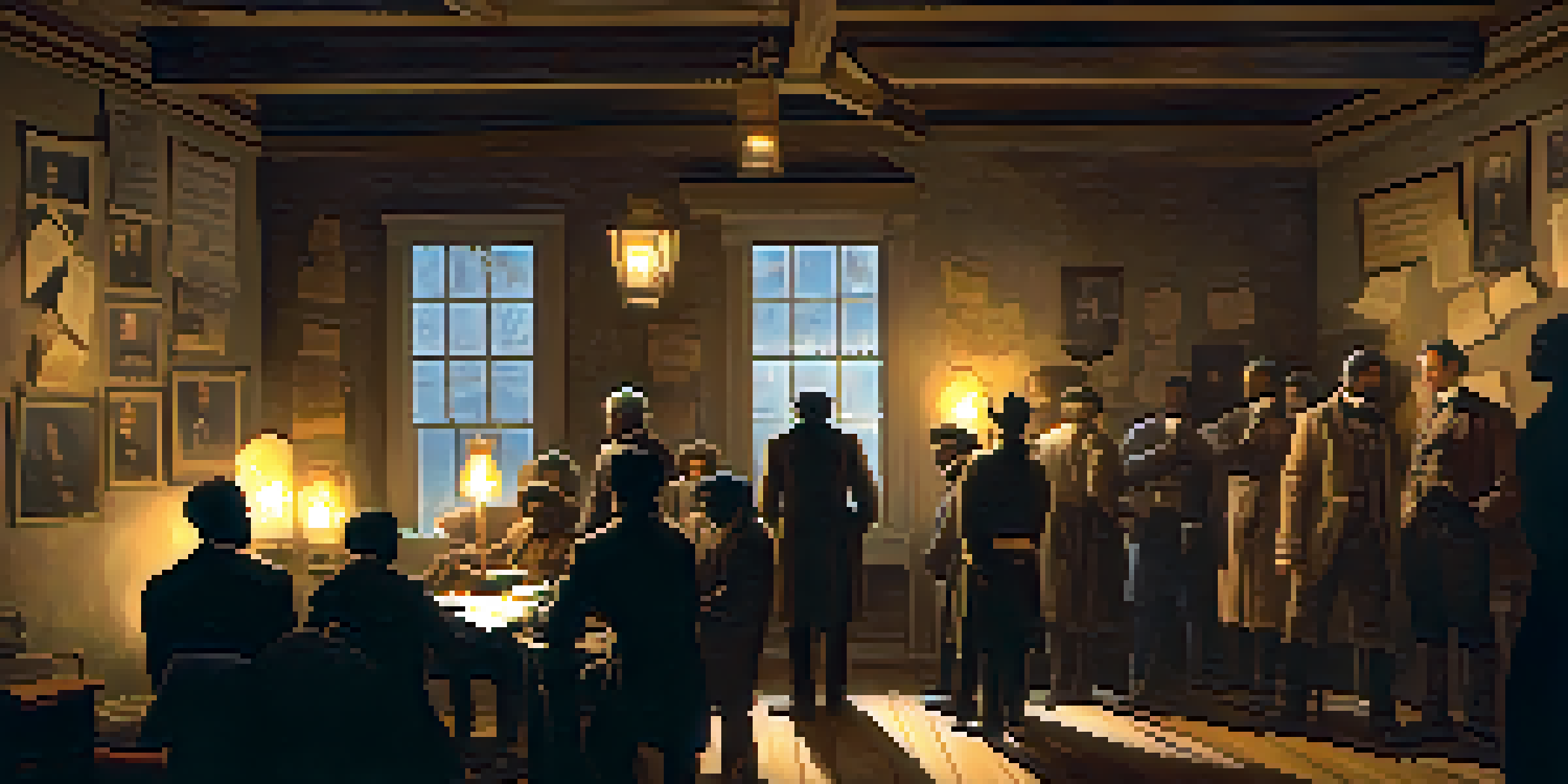The Underground Railroad: A Trail of Courage and Resilience

Understanding the Underground Railroad's Purpose and Origins
The Underground Railroad was a network of secret routes and safe houses that helped enslaved African Americans escape to freedom in the 19th century. Its origins can be traced to the early abolitionist movement, which sought to end slavery in the United States. As the plight of enslaved individuals became more widely known, courageous allies from both free and enslaved communities began to band together.
I freed a thousand slaves. I could have freed a thousand more if only they knew they were slaves.
This initiative was not an actual railroad, but rather a metaphorical one that used train terminology to describe the escape process. For example, 'conductors' were the individuals who guided the escaping slaves, while 'stations' referred to the safe houses where they could hide. The creativity in this naming helped maintain secrecy and fostered a sense of unity among those involved.
The Underground Railroad developed into a lifeline for many, illustrating the deep commitment to justice and equality that marked this period in American history. It became a symbol of hope and resistance, demonstrating the lengths to which individuals would go to secure their freedom and the freedom of others.
Key Figures Who Shaped the Underground Railroad
Several remarkable individuals played pivotal roles in the Underground Railroad, with Harriet Tubman being one of the most famous. Born into slavery, Tubman escaped to freedom and returned multiple times to rescue others, earning her the nickname 'Moses' for her leadership and bravery. Her commitment to the cause exemplified the resilience and courage of many.

Another significant figure was Frederick Douglass, an escaped slave who became a prominent abolitionist and orator. Douglass used his powerful voice to advocate for the rights of African Americans and worked tirelessly to support the Underground Railroad's efforts. His writings and speeches inspired countless others to join the fight against slavery.
Abolitionists' Impact on Freedom
Abolitionists and allies played a crucial role in the Underground Railroad, using their platforms to advocate for the end of slavery and support escapees.
These individuals, along with many others, created a network of support that was crucial for the success of the Underground Railroad. Their stories remind us of the strength of the human spirit and the importance of standing up for justice, even in the face of overwhelming odds.
The Risks Involved in Assisting Escaped Slaves
Assisting enslaved individuals on their journey to freedom was fraught with danger. Those who helped risked their own safety and livelihoods, as the Fugitive Slave Act imposed severe penalties on anyone caught aiding escapees. This law created a climate of fear, yet many chose to act bravely, believing in the moral imperative to help.
If there is no struggle, there is no progress.
For instance, conductors often had to navigate perilous routes, avoiding slave catchers and other dangers. They used various strategies, such as traveling at night and employing codes to communicate, all while maintaining an unwavering commitment to their cause. The secrecy surrounding these operations added to the tension and urgency of the missions.
Despite the risks, the determination of those involved never wavered. Their actions not only saved lives but also contributed to the larger movement against slavery, showing that courage can triumph even in the darkest of times.
The Role of Abolitionists and Allies
Abolitionists played a crucial role in the success of the Underground Railroad, using their platforms to raise awareness about the horrors of slavery. They organized rallies, published pamphlets, and lobbied for legal reforms, all aimed at ending the institution of slavery. Their efforts provided much-needed support and resources for those risking their lives to help others.
Many abolitionists were white individuals who stood in solidarity with the African American community. This alliance demonstrated the power of collective action, as people from diverse backgrounds came together for a common cause. These partnerships were essential in creating safe havens and expanding the network of the Underground Railroad.
Courage in the Face of Danger
The individuals involved in the Underground Railroad risked their safety and livelihoods to assist those seeking freedom, demonstrating remarkable bravery and resilience.
The collaboration between abolitionists and those escaping slavery highlighted the importance of mutual support in the fight for justice. It serves as a reminder that change often requires the courage of many, working together to confront systemic injustice.
The Journey to Freedom: Stories of Escapees
The journeys taken by those escaping slavery were often harrowing and full of uncertainty. Many escapees traveled hundreds of miles, facing natural obstacles, hostile terrain, and the constant threat of capture. Each story is unique, filled with moments of fear and hope as individuals sought to reclaim their freedom.
One remarkable story is that of William Still, a free African American who documented the experiences of escapees in his book, 'The Underground Railroad.' His accounts provide a glimpse into the lives of those who risked everything to seek freedom, revealing the courage and resilience that defined their journeys.
These personal narratives not only highlight the struggles faced by escapees but also celebrate their triumphs. Each successful escape contributed to the collective memory of resistance and perseverance, reminding us of the human spirit's capacity to overcome adversity.
The Impact of the Underground Railroad on American Society
The Underground Railroad had a profound impact on American society, challenging the institution of slavery and inspiring future generations. It helped to raise awareness about the plight of enslaved people, galvanizing support for the abolitionist movement and leading to significant social change. The stories of courage and resilience served as powerful motivators for those fighting for justice.
Additionally, the Underground Railroad laid the groundwork for the Civil Rights Movement. The principles of freedom, equality, and justice that emerged from this era would resonate through history, influencing countless activists and leaders in the years to come. It became a testament to the power of grassroots movements in effecting real change.
Legacy of Resistance and Hope
The Underground Railroad significantly influenced American society by challenging slavery and inspiring future movements for justice and equality.
The legacy of the Underground Railroad continues to be felt today, as it reminds us of the ongoing struggle for human rights. It encourages us to reflect on our own roles in advocating for justice and equality in society, ensuring that the lessons learned from this chapter in history are not forgotten.
Commemorating the Underground Railroad Today
Today, the legacy of the Underground Railroad is commemorated through various initiatives, including museums, historical sites, and educational programs. These efforts aim to honor the bravery of those who participated and to educate future generations about the importance of this critical chapter in American history. It helps to keep the stories of courage alive.
Events such as the Underground Railroad Month, celebrated in various communities, serve to raise awareness and encourage dialogue about the ongoing issues of racism and inequality. By remembering the past, we can inspire action in the present and future, fostering a society that values justice and inclusion.

Commemorating the Underground Railroad is not just about remembering; it's about recognizing the lessons it teaches us today. As we reflect on the courage of those who fought for freedom, we are reminded of our responsibility to continue their work and advocate for a more just world.